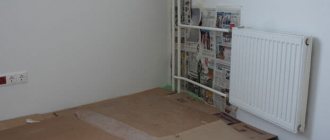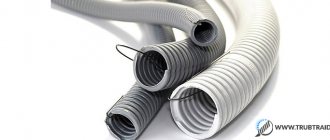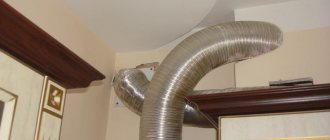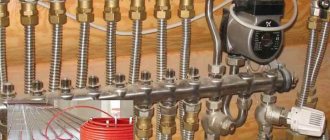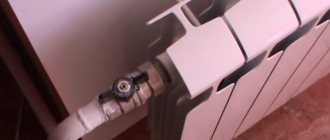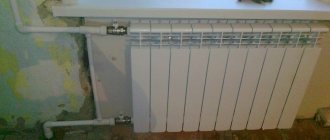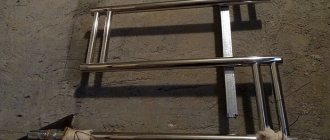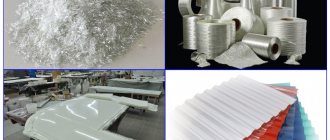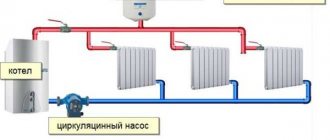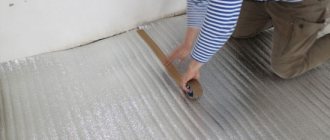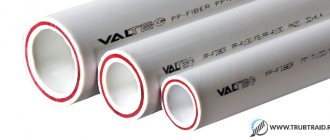Just a decade ago, only smooth-walled pipes were considered in heating systems. Now the market of materials for installation of heating systems has been replenished with an interesting new product, which are corrugated pipes for heating. The combination of the flexibility of corrugation and the strength of stainless steel has proven to be very successful, and many modern heating systems are installed using these particular products.
Corrugated pipes are one of the newest materials for heating systems.
Why corrugation is a good option for heating
The popularity of these products is due to the fact that they help solve many problems that arise during the installation and repair of heating systems. Corrugated stainless steel has the following advantages:
- Ability to operate in a wide temperature range, from -50 to +110 ⁰C.
- Ability to withstand coolant pressure surges up to 200 Bar with a maximum long-term 50, operating index - 15.
- Ease of bending without the use of any devices with a minimum radius equal to 3 pipe diameters. This allows you to make do with a minimum of joints even when creating systems with complex configurations.
- Possibility of quickly replacing damaged areas.
- High anti-corrosion resistance.
- Durability of use. The temporary life of the system is determined by the service life of the fittings, which is 30 years.
- No formation of deposits and build-ups. The smooth internal surface prevents this, ensuring quiet operation of the system.
- Smoothing out significant thermal expansion, which allows you to lay communications without the use of expansion joints.
- Painlessly withstands up to 40 freeze/thaw cycles.
There are few disadvantages, but they should be taken into account when maintaining and installing products. These include:
- the need for regular tightening of fittings - complicates hidden installation in the walls, since it is necessary to ensure free access to the joints;
- low resistance to impact, therefore, in places where there is a high probability of damage, protective covers should be provided;
- the difficulty of maintenance, since the accumulated dust cannot be wiped off with a cloth, you will have to work with a brush;
- unpresentable appearance, which can be hidden behind a nice screen, at the same time solving the problem of dust protection;
- the need for reliable grounding due to high electrical conductivity to protect against stray currents.
Application nuances
The scope of use of stainless steel in the heating sector is extensive, which makes it possible to use corrugation when arranging complex pipelines at industrial facilities and simple heating systems in different facilities. Unique flexibility, resistance to moisture and pressure make corrugated pipe an excellent solution for creating heated floors. It guarantees a high thermal conductivity parameter and heats concrete up to 100 mm thick.
Corrugated heating pipes, due to their characteristics, require special attention already at the purchase stage. Pay attention to the appearance of the product. Signs of damage, rust or fractures can lead to problems during operation. During installation, check the quality of the joints, because corrugated pipe is very flexible and if laid incorrectly, there is a high risk of leakage. If there are no errors, the service life is 20 years or more.
Pay attention to the certificates of conformity confirming the quality and possibility of using corrugations in the heating system. Check the quality of the cut, any damage to the edges and the sufficiency of the contents. As a rule, the kit includes fittings for combining sections. We will dwell on the issue of choice in more detail.
Which corrugation is better
There are 2 types of corrugated stainless steel pipes available:
- heat treated;
- unannealed.
When heated to a high temperature followed by slow cooling, the pipes become more flexible and softer. They retain their shape better, withstand more bending/extension without compromising their integrity, but they cost 1.5 times more.
Unannealed pipes do not differ in appearance from processed products, but slight deformation may occur at the bend site. Therefore, in order to save money, it is better to use them for laying straight sections. In systems with a large number of turns and in the manufacture of radiators, annealed pipes will be more reliable.
Dimensions
The production of corrugated products is regulated by GOST 3262-75. They are produced in coils with a length of 10-50 m, but upon individual orders it is possible to increase it. Depending on the internal cross-section for corrugated flexible pipes, the dimensions indicated in the table are established.
| Nominal diameter | 8A | 12A | 15A | 18A | 20A | 25A | 32A | 40A | 50A |
| External diameter | 12.8 | 16.2 | 18.1 | 20.3 | 25.6 | 32 | 37.6 | 48 | 59.8 |
| Inner diameter | 9.7 | 12.7 | 14.1 | 16.5 | 21.1 | 27 | 32.1 | 42 | 53.5 |
| Wall thickness | 0.3 (0.25) | 0.3 (0.25) | 0.3 (0.25) | 0.3 (0.25) | 0.3 (0.25) | 0.3 (0.25) | 0.3 (0.25) | 0.4 (0.3) | 0.4 (0.3) |
| Number of corrugation turns per 10 cm, not less | 25 | 24 | 23 | 21 | 19 | 18 | 18 | 14 | 13 |
| Minimum bend radius, mm | Up to 20 | Up to 30 | Up to 30 | Up to 40 | Up to 40 | Up to 50 | Up to 80 | Up to 120 | Up to 150 |
| Standard length, m | 60 | 60 | 50 | 40 | 30 | 30 | 20 | 10 | 10 |
Calculations
To create a heating system, you need to calculate the required power of the pipes. The reliability of the system will depend on this. It is important that during the winter season all rooms in a private house or apartment are heated evenly. This can be achieved by installing channels of sufficient diameter. To find out the required section size you need to use the following formula: D = sqrt ((314∙Q)/ (V∙DT)).
Below you will find out what these variables mean:
- sqrt – square root;
- DT is the temperature difference between the inlet and outlet;
- V is the speed of the carrier;
- Q—heat flow;
- D – internal diameter indicator.
To simplify the calculations, you can use the corresponding table. It will save time .
Alternative options
In addition to stainless steel, plastic and cast iron are used to make pipes with corrugated surfaces. However, the scope of use of polymer products is limited by a maximum permissible temperature of 85 ⁰C and a maximum pressure of no more than 20 atm. Cast iron can withstand significant thermal loads, but its heavy weight, low impact resistance and complex installation do not contribute to its widespread use.
Practice of use
Corrugated pipes are widely used. Due to ease of installation, accessibility and unique properties, they are relevant in a variety of areas. Based on practice, corrugation is useful in the following cases:
- Arrangement of heating units using solar collectors.
- Warm floor.
- Connection to batteries
- Hot or cold water supply.
- Connecting dishwashers and geysers.
- Installation of taps and mixers.
- Laying cable products, etc.
The choice of corrugated pipe is due to its ability to withstand high heat and pressure up to six atmospheres. I am attracted by the ease of installation and flexibility of the material.
What to look for when purchasing
Due to the high cost of production technology, there are no fakes yet. Rarely, but factory defects occur. Due to the difficulty of applying markings to the corrugated surface, it is printed on the packaging of the coils. Unscrupulous traders take advantage of this by replacing the wrapping in order to pass off inexpensive products as high-quality ones. Therefore, first of all, you should pay attention to the condition of the packaging.
The surface of the pipe is checked for deformations and damage. The spaces between the corrugation rings must be the same along the entire length of the product. A high-quality pipe returns to its original position after bending. Cracks, chips or other damage are not allowed on the seam.
You need to pay no less attention to the choice of fittings, as the quality of the system depends on them. They must have a smooth and even surface and must include O-rings. The presence of cracks and damage on gaskets is unacceptable. To confirm the quality of the product, the seller must provide a certificate of conformity.
Manufacturers and approximate prices
Cost and characteristics depend on manufacturers. A significant segment of the Russian market for corrugated pipes is occupied by South Korean companies. Due to their excellent quality, German companies in Russia are included in the rating.
Reliable manufacturers include:
- KOFULSO. A representative of South Korea, whose products are considered the standard by experts. It produces multifunctional corrugated stainless steel pipes with a diameter of 15-50 mm. The fittings are equipped with sealing gaskets of increased thickness, which improves the quality of installation. The range is represented by heat-treated and unannealed pipes, rolled into coils of 10-50 m. The cost per linear meter is 170-2500 rubles.
- NEPTUN. Represents the Russian company, whose products are supplied to 40 countries. Offers pipes with a diameter of 15-32 mm for universal purposes, used in the installation of gas pipelines, heating systems and hot water supply, piping domestic heating boilers. Cost – 85-700 rubles.
- LAVITA. A South Korean company that produces not only annealed and untreated pipes, but also jacketed products with a diameter of 8-50 mm. In general, there are no complaints about the quality, but there have been isolated (1-2 per hundred) cases of leaks in the places where the fittings are attached, which violate the integrity of the pipe wall. However, experienced installers believe that this occurs as a result of the excessive zeal of beginners who tighten the nuts too much. Cost – 85-700 rubles.
- HYDROSTA. Also a company from South Korea. The products are manufactured using a special polishing technology to reliably protect the inner surface of the pipe from deposits and build-up. Used for installation of any plumbing fixtures, except sewerage. Diameter – 12-50 mm, cost – 125-1500 rubles. There are complaints about manufacturing defects. Up to 7% of fittings leak after installation, regardless of the skill level of the workers.
- INOFLEX. Flexible stainless steel pipes from the German company MEIBES with a diameter of 12-40 mm are sold under this brand. They are designed to operate at temperatures up to 200 ⁰C and pressure 16 Bar. Sold in coils 20-80 m long at a price of 650-2000 rubles per meter. Despite the high quality, experts believe that the cost is too high.
Production of corrugated stainless steel pipes
Corrugated pipe for heating systems was invented in Japan. But a larger quantity of this type of pipe products is manufactured today in South Korea.
We recommend that you read: How to make a chimney passage through a metal roof with your own hands
The technological process is fully automated and goes through several stages:
- At the forming line, a steel strip, which will later become a pipe, passes through a system of bending machines, becoming a cylindrical smooth-walled blank.
- Special clamps deform the workpiece, turning the smooth-walled surface of the pipe into a corrugated one - this is how the rolling process occurs.
- The pipe is placed in a vessel with a gas mixture, thanks to which the pipe will obtain properties characteristic of stainless metals. Welding of joints is done only with the help of automatic equipment: eliminating the human factor reduces the risk of accidental errors.
- Stainless steel corrugation gains plasticity when it is heated to 1150 °C and then cooled to -400 °C. But not every manufacturer subjects corrugated pipes to this procedure.
- The resulting pipe is cut into segments (length up to 50 m), which are then wound onto coils.
Note! Outwardly, it is impossible to understand the difference between pipes that have not been annealed and pipes that have been heated, but the difference in quality, and therefore in price, is significant. A product that has undergone annealing is more ductile and stronger.
After manufacturing, the product is tested for leaks: the coil with a piece of pipe is placed in water and at the same time air is supplied under pressure.
Installation
When installing corrugated stainless steel pipes, there are a few things to consider. You should not test the strength of products by bending them several times over a short area. Having given the pipe the required shape, there is no need to strive for perfection by repeated changes. The strength of stainless steel is not unlimited, so there is a high probability of cracks and therefore leaks.
To prevent the corrugation from sagging in horizontal sections, more attachment points will be required than for conventional pipes. This will have little effect on the cost of installation, since the price of the clamps is low. The method of connecting pipeline components is generally similar to joining with compression fittings. However, the parts connecting the corrugation do not have fittings. The crimping is carried out by a gasket installed inside the brass fitting.
Welding
Traditionally, electric welding was used to connect metal channels. This operation allows you to reliably connect two products together. The quality of its implementation must be extremely high. The performance of the entire circuit depends on how well the joint is made. If the welding was done poorly, a leak may occur in the near future.
Connections by welding can be made:
- in the corner;
- end-to-end;
- vtavr;
- overlap
Note that when installing heating ducts, butt welding is predominantly used. This method allows you to create the most reliable joint. Therefore, always connect products exclusively end-to-end.
Connection methods
To obtain an even cut at the joined end, it is better to use a pipe cutter for corrugated products. You should not use a grinder, since there is a high probability of wall deformation. When joining a corrugated and a regular pipe, fixing the fitting begins from the side of the smooth element.
Flexible radiator connection
The batteries are connected to the heating system using a manual roller. After cutting a piece of corrugated pipe to the required length, its ends are cleaned of burrs. Then one of them is inserted into the opening of the rolling machine so that two turns of corrugation protrude. They are flared with a hammer.
Then put on the union nut, not forgetting to insert the rubber gasket into it. The second end is prepared in the same way. After fixing the fittings on the riser and radiator pipes, tighten the nuts on the corrugation. In this case, you need to ensure that the flexible pipe does not twist. If leaks are detected during hydraulic testing, the nuts on the fittings must be tightened. To prevent the corrugation from dangling, you should fix it on the wall.
Warm floor
In this case, it is recommended to install the pipe using plastic clips. They are attached with dowels to the concrete screed through holes drilled in the insulation. The clips are placed in accordance with the selected floor heating scheme. The optimal distance between pipeline branches is 30 cm, and from the walls - no less than 20 cm.
Installation begins by connecting one end to the supply pipe of the distribution cabinet. Then the coil is rolled out and the corrugation is secured in clips. If the length is not enough, the joints need to be brought out near the walls to ensure easy access to them. Excess residues are cut off, the second end is connected to the return pipe of the manifold. To protect against stray currents that can cause electrochemical corrosion, a stainless steel circuit is grounded or pipes in a polymer sheath are used.

